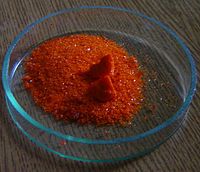Ammonium dichromate
 |
|
 |
|
 |
|
| Names | |
|---|---|
|
IUPAC name
Ammonium dichromate
|
|
| Other names
Ammonium bichromate
Ammonium pyrochromate |
|
| Identifiers | |
|
7789-09-5 |
|
| 3D model (Jmol) | Interactive image |
| ChemSpider |
23002 |
| ECHA InfoCard | 100.029.221 |
| PubChem | 24600 |
| RTECS number | HX7650000 |
| UNII |
5J18BP595G |
| UN number | 1439 |
|
|
|
|
| Properties | |
| (NH4)2Cr2O7 | |
| Molar mass | 252.07 g/mol |
| Appearance | Orange-red crystals |
| Density | 2.115 g/cm3 |
| Melting point | 180 °C (356 °F; 453 K) decomposes |
| 18.2 g/100ml (0 °C) 35.6 g/100ml (20 °C) 40 g/100ml (25 °C) 156 g/100ml (100 °C) |
|
| Solubility | insoluble in acetone soluble in alcohol |
| Hazards | |
| Safety data sheet | ICSC 1368 |
| GHS pictograms |
    
|
| H272, H301, H312, H314, H317, H330, H334, H340, H350, H360, H372, H410 | |
| P201, P220, P260, P273, P280, P284 | |
|
EU classification (DSD)
|
Carc. Cat. 2 Muta. Cat. 2 Repr. Cat. 2 |
| R-phrases | R45, R46, R60, R61, R2, R8, R21, R25, R26, R34, R42/43, R48/23, R50/53 |
| S-phrases | S53, S45, S60, S61 |
| NFPA 704 | |
| 190 °C (374 °F; 463 K) | |
| Related compounds | |
|
Other cations
|
Potassium dichromate Sodium dichromate |
|
Except where otherwise noted, data are given for materials in their standard state (at 25 °C [77 °F], 100 kPa).
|
|
|
|
|
| Infobox references | |
Ammonium dichromate is the inorganic compound with the formula (NH4)2Cr2O7. In this compound, as in all chromates and dichromates, chromium is in a +6 oxidation state, commonly known as hexavalent chromium. It is a salt consisting of ammonium ions and dichromate ions.
Ammonium dichromate is sometimes known as Vesuvian Fire, because of its use in demonstrations of tabletop "volcanoes". However, this demonstration has become unpopular in schools due to the compound's carcinogenic nature. It has also been used in pyrotechnics and in the early days of photography.
At room temperature and pressure, the compound exists as orange, acidic crystals soluble in water and alcohol. It is formed by the action of chromic acid on ammonium hydroxide with subsequent crystallisation.
The (NH4)2Cr2O7 crystal (C2/c, z=4) contains a single type of ammonium ion, at sites of symmetry C1(2,3). Each NH4+ centre is surrounded irregularly by eight oxygen atoms at N—O distances ranging from ca. 2.83 to ca. 3.17 Å, typical of hydrogen bonds.
It has been used in pyrotechnics and in the early days of photography as well as in lithography, as a source of pure nitrogen in the laboratory, and as a catalyst. It is also used as a mordant for dyeing pigments, in the manufacturing of alizarin, chrome alum, leather tanning and oil purification.
...
Wikipedia

